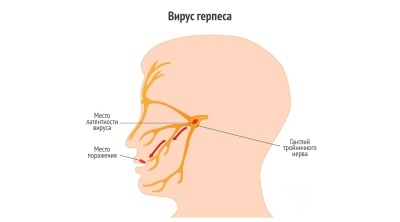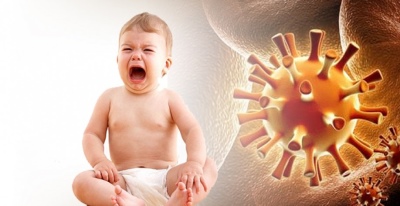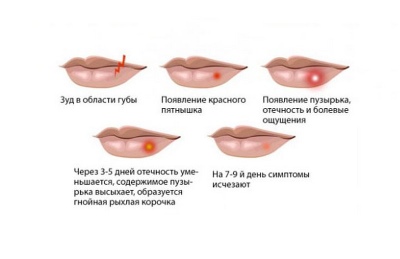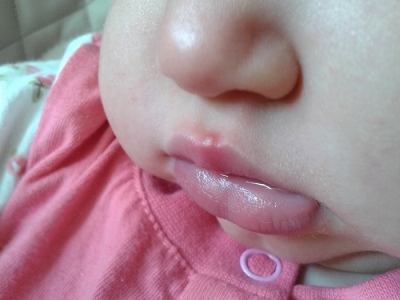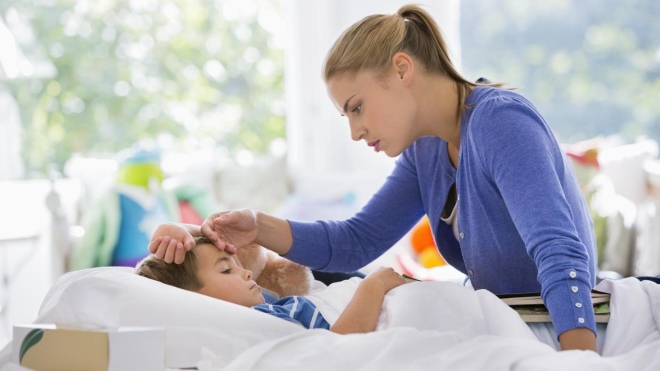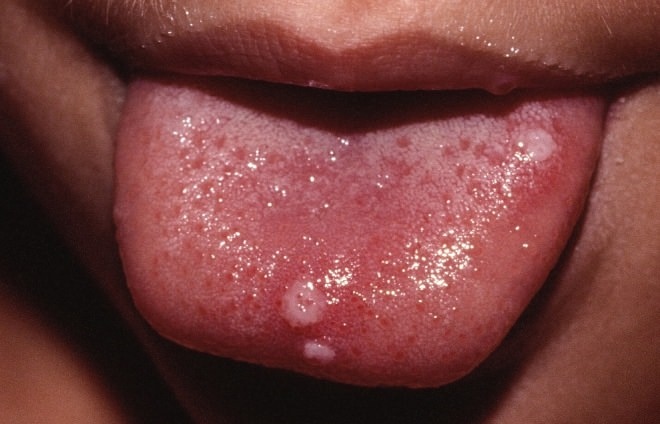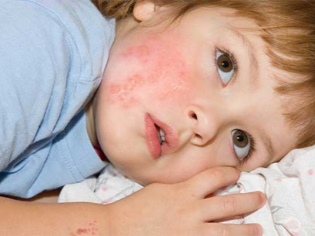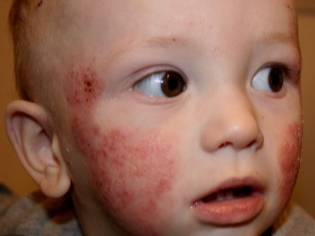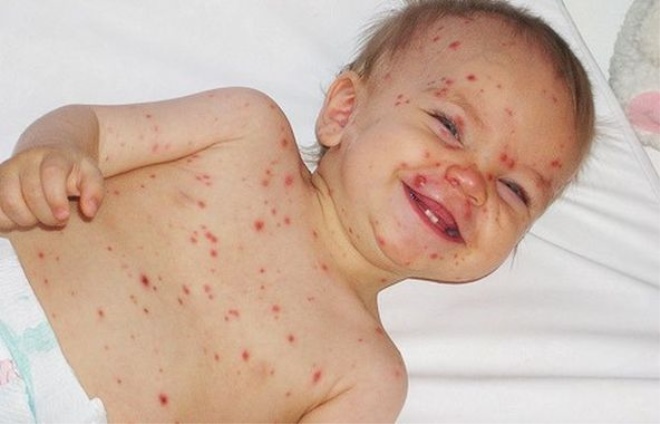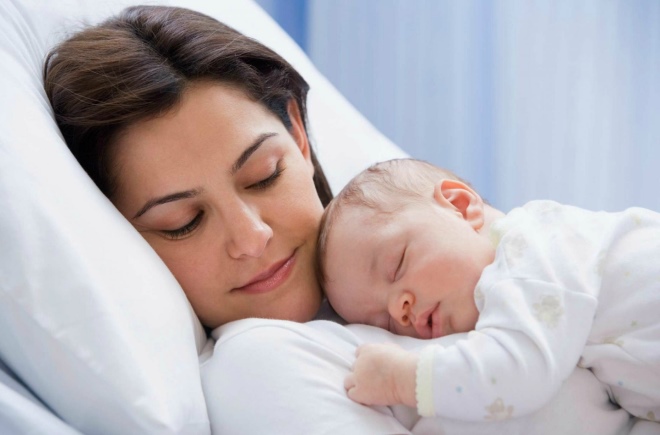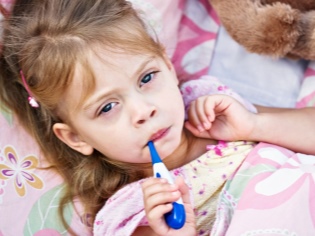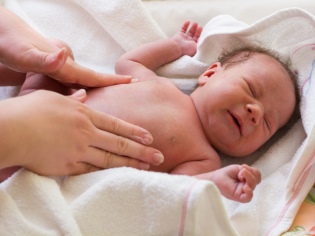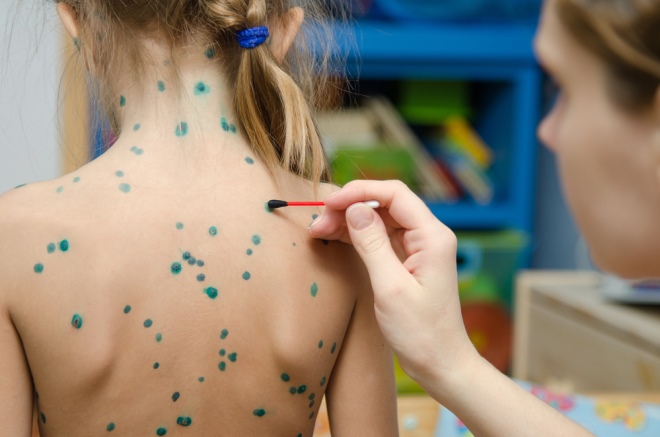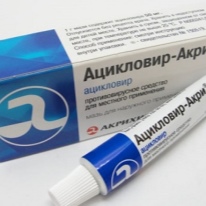Symptoms and treatment of herpes in children
Increasingly, doctors register in children various forms of herpes infections. These diseases have a chronic course that requires mandatory monitoring by parents and physicians. Not everyone knows the symptoms and treatment of herpes in children.
Types of virus
Currently, scientists have discovered 8 types of viral herpes. These harmful microorganisms very easily cause herpes infection in young children. The structure of only three subtypes of eight has been well studied. They are the most described and studied. These infectious agents most often cause babies to have "cold" symptoms. lips and in the intimate area.
In literal translation, herpes lesion means "creeping disease." Doctors gave this name to the disease several centuries ago. The peculiarity of this virus is that the favorite places for its occurrence are various mucous membranes. Microbes have a toxic effect on epithelial cells, which leads to the appearance of various adverse symptoms.
In children's practice, the most common 8 subspecies of viruses that cause the baby various injuries:
- Type 1. Most often contribute to the development of a child of various lesions on the mucous membranes of the lips.
- Type 2. Causes a rash on the mucous membranes of the genitals.
- Type 3. It belongs to the subspecies of the virus, which is capable of causing chickenpox or surrounding disease in a baby.
- Type 4. Doctors call it the Epstein-Barr herpes virus. These microorganisms are capable of causing manifestations of infectious mononucleosis in a baby.
- Type 5. It is responsible for the development of cytomegalovirus infection.
- Type 6. Pretty new subspecies of the virus. Scientists conduct a large number of different studies in order to study in detail the infectious and virulent properties of this microorganism. This type of herpes can cause manifestations of multiple sclerosis or the development of sudden exanthema.
- Type 7. Not described in detail. Currently, researchers are studying the properties of this microorganism. There is scientific evidence that this particular species is responsible for the development of a sudden skin rash in a baby and leads to the development of chronic fatigue.
- Type 8. Enough adverse subspecies of the virus. May contribute to the development of malignant neoplasms on the skin. There are scientific studies that indicate that this particular virus contributes to the development of Kaposi's sarcoma.
Incubation period
Most viral diseases are highly contagious. Herpes is no exception. A sick person who has a high concentration of viruses in his blood is contagious. Focusing on the statistics, it can be noted that the greatest number of cases of the disease is caused by the herpes simplex subtype. It contributes to the development of adverse symptoms of herpes infection in 90% of children.
For a long time, the child may not suspect that it is already infected with herpes. The infection in this case proceeds in his latent form. With this variant of the disease there are no symptoms. The latent form is found in about 5% of babies.
Usually, the herpes virus infection occurs during initial contact with an infected person.The incubation period for different subtypes of the virus may be different. The first symptoms of the disease may appear as after a couple of days from the moment the pathogen enters the child’s body, or several months later.
The duration of the incubation period depends on many factors and initial data. An important role in this is played by the level of the immune system. If the baby’s immunity is strong, then the symptoms of the disease can be expressed slightly (or absent altogether) - for a long period of time. Usually they appear only with poor functioning of the immune system.
The incubation period for herpes simplex type 1 is usually from a few days to a couple of weeks. In this case, the first rash appears on the mucous membranes of the lips and mouth. Genital herpes, causing a rash in the intimate area, causes uncomfortable symptoms usually after 6-7 days. Girdle variants of the disease have a longer incubation period. In some cases, it may be several months (or even years).
Main symptoms
Different subtypes of viruses can settle on different mucous membranes. This causes a large variety of localizations. Each type of herpes has its own clinical features. This is due to the properties of the virus particles themselves. The infection manifests itself in babies in different ways.
Herpes may cause the following clinical manifestations in a child:
- Increased body temperature. It usually increases to febrile values. The peak of fever falls on the first 3-4 days from the beginning of the acute period of the disease. The temperature usually decreases quickly. Normalization requires the appointment of anti-inflammatory and antipyretic drugs.
- The appearance of a rash. It is represented by a set of numerous formations within which there is a liquid. These rashes look like bubbles filled with content. Localization of the rash is determined by the type of virus that caused the disease.
- Swollen lymph nodes. Regional lymph collectors are usually affected. If the virus causes a rash on the upper half of the body, then the cervical, parotid, submandibular and subclavicular lymph nodes will be involved. They increase in size, become tightly welded to the skin. When feeling them in a child may appear sore.
- Symptoms of intoxication. The abundance of viral toxins has a toxic effect on the entire body. The child feels "broken", becomes very sluggish. In children, appetite and sleep are disturbed. Infants often refuse breastfeeding.
- Behavior change. Kids are becoming more capricious. Children of the first years of life do not make contact well. More severe forms of the disease lead to an increase in drowsiness. Unbearable itching of skin rashes contributes to increased anxiety and nervousness in the baby.
- Soreness in places of herpetic vesicles. Herpes rash usually itches very much. In the case of the shingles, the pain spreads along the damaged nerve. After the disappearance of the rash pain syndrome passes.
In the mouth
Most often, this option is caused by the herpes virus type 1. The child has all the symptoms described above. Herpetic rash has several features. With herpes simplex virus, it can occur on the tonsils, cheek, on the tongue. The rash is represented by various multiple bubbles, inside of which there is a liquid.
The liquid component is usually grayish or reddish. Herpetic bubbles protrude a few millimeters above the surface of the skin. In severe cases, they can be numerous and rather large in size. A certain complexity is represented by such rashes on the glands. They can easily break through and be injured during meals.
This type of herpes is also characterized by an increase in the parotid and a group of cervical lymph nodes. In some cases, they even become visible from the naked eye. The baby's body temperature rises to 38-38.5 degrees. The abundance of rash leads to severe pain when swallowing. This contributes to poor appetite.
Lip rash
Most often found in a simple virus infection. Typically, the development of this herpetic rash contributes to the subtype 1. The disease is characterized by the appearance of numerous bubbles filled with serous bloody fluid from the inside. These formations are easily injured. Even a small injury can cause capillary bleeding.
The danger still lies in the fact that if such bubbles are damaged, open wounds appear. They can easily penetrate a secondary bacterial infection. This leads to the development of viral and bacterial conditions. You can notice such changes at home. When bacteria enter, the bubbles begin to fester.
The red border of the lips is the most favorite localization for herpes simplex viruses. The rash does not appear immediately. First, the damaged area begins to itch. After a couple of hours or by the end of the first day after the onset of severe itching, bubbles begin to appear. When they appear, itching increases several times.
Usually the bubbles remain on the skin for 6-12 days. After an acute period of illness, they completely disappear from the skin. In their place a dry crust appears, which after some time disappears on its own. In some cases, there is preservation of moderate itching and redness of damaged skin.
Herpetic eruption on face
Such localization is not the most common. Usually, this form of herpes infection is found in weakened and frequently ill children, as well as children with various forms of immunodeficiency states. With this variant of the disease, red itchy blisters appear on the nose, chin, forehead, and eyelid. Severe forms of the disease are accompanied by the occurrence of herpetic eruptions on almost the entire surface of the skin.
Each subspecies of herpes has its own favorite sites and some features of the development of adverse symptoms. Thus, with herpes simplex virus type 1, bubbles appear predominantly in the nasolabial triangle area. In the case of the shingles, the rash does not only cover the face, they appear all over the body. Chickenpox is characterized by the stepwise appearance of a rash. In some cases, it also appears on the head, in the area of the hair.
After the disappearance of the bubbles on the skin remain crusts. Usually they differ in color from the surrounding skin. Crusts have a reddish or red-brown color. After a couple of days, they completely disappear, and the skin becomes pale pink and clean again. Itching usually disappears after 5-6 days from the moment the first rash appears on the face.
What does the shingles look like?
The herpes virus type 3 leads to the development of this disease. This viral subtype is quite virulent. The risk of infection is quite high. Usually, children attending kindergarten and preschool institutions are more likely to become infected with the girdle form. Herpes virus for a long time can be in the environment. Only prolonged exposure to high temperatures and ultraviolet radiation leads to its destruction.
Most often, doctors note a disease surrounding the form of infection in babies who have recently had chickenpox. This is largely due to the peculiarities of the immune system. Weakened immunity can not cope with the attack of pathogenic viruses. Often sick children and toddlers with immunodeficiencies are also at increased risk.
Once in the children's body, viruses can stay in a “sleepy” state for quite a long time. Usually with the blood flow they get into the nerve ganglia, where they can maintain their viability for a long time without losing their virulent properties. Under adverse conditions, they begin to actively multiply and cause the appearance of the classic symptoms of a herpetic infection in a baby.
In the case of the surrounding shape, herpetic vesicles appear on almost the entire body. Their location depends on the affected nerve. They can be located on the leg, arm, back, front surface of the chest. The rarest location for girdling forms is the location on the palms and feet. In such cases, painful blisters predominantly appear on the skin of the fingers.
The development of rashes goes through several successive stages. The first to appear is severe redness. After a couple of hours there is a mild itching, which over time becomes unbearable. The next stage is the appearance of bubbles. Inside them is a serous fluid. Herpetic bubbles remain on the skin for three to four weeks.
Then they disappear, and ulcers form in their place. If at this time the secondary bacterial flora does not fall on the area of the damaged areas, they heal and crusts form. Crusts can persist for a week. Itching at this time is markedly reduced. A week later, the crusts begin to fall away on their own.
After a previous illness, only areas of depigmented skin can remain on the skin. This is a temporary occurrence. Usually, over time, this symptom disappears completely. In the future, the child's skin becomes clean, without a trace of herpes infection.
Skin rashes also accompany other symptoms. These include an increase in temperature to febrile values, pain and an increase in cervical and axillary lymph nodes, increasing headache and severe weakness. They usually persist during the entire acute period of the disease. To eliminate them requires the appointment of anti-inflammatory drugs and abundant warm drinking.
Doctors usually note that the severity of the disease depends on the age of the patient. The younger the child, the easier it carries this form of herpes infection. In older adults, the disease is rather difficult to tolerate. Some patients with severe herpes zoster are even hospitalized to the hospital. They are shown conducting intensive treatment.
In the intimate area
The defeat of the genital organs with herpes infection is a fairly common pathology found in pediatric medical practice. This disease is caused by the herpes virus type 2. It is distinguished by its peculiarity of striking the mucous membranes of the genital organs. The severity of the disease depends on the age of the child, the presence of concomitant chronic diseases, as well as the state of his immunity.
This variant of herpes infection is usually sexually transmitted. However, in children there are some features of disease transmission. They can also become infected during fetal development - transcervical. In this case, the viruses enter the bloodstream along with the amniotic fluid. The transplacental method promotes the transfer of microorganisms through the blood vessels of the placenta.
Scientists also note the variant of infection through the fallopian tubes - transovarially. Quite a frequent way of infection - during childbirth. Even minor injuries contribute to the easy entry of viruses into the children's body. This option is also called contact. Doctors note that children usually very easily become infected with a herpetic infection during birth.
The most significant susceptibility to infection with herpes viruses type 2 - in children aged from six months to three years. The immune system of children at this age is not fully functioning.This contributes to the fact that the child's body can not cope with the destruction of viruses on their own. After the initial contact, clinical symptoms usually appear only in 10% of cases. The rest of the infection remains in a latent form.
Most cases of herpes simplex virus type 2 occur during adolescence. The infection option in this case is sexual or contact-household. After 5-7 days in children, the first adverse symptoms of the disease appear. They may persist for several weeks. The interruption of the acute period of the disease does not indicate a complete recovery. Very often the course is chronic.
The classic symptom of "genital" herpes are numerous blisters. They are located on the external genitals. These skin elements are quite itchy. In some cases, itching may be intolerable. Time of day does not matter. The itch can disturb the child both in the afternoon, and at night.
After the disappearance of bubbles on the skin remains erosion and wounds. For epithelialization will take some time. It usually takes 5-6 days. Then the mucosa is fully restored and heals. Traces of the disease does not remain.
The child is quite disturbed overall health. The kid feels bad, he grows nervous. Small children are often naughty, kids can often ask for pens. Body temperature usually increases to 38-39 degrees. Against the background of febrile, the child may appear chills, as well as fever.
Symptoms of intoxication are also significantly pronounced. In these forms of the disease, headache, sleep and appetite disturbances, as well as fatigue are frequent. It is important to note that this virus subtype contributes to the development of relapses. Any condition that leads to a decrease in immunity leads to the appearance of new rashes on the skin. Such relapses may occur even several years after the first exacerbation.
Mild forms of genital herpes occur in 90-95% of children. In other cases, the disease proceeds with a severe course. This condition requires emergency hospitalization of the child in the hospital. There for the baby will hold all the necessary complex antiviral and anti-inflammatory treatment.
Genital disease in a newborn and one year old child
Every day, doctors began to notice an increasing number of cases of infection with this particular form of herpes infection. Babies are predominantly infected during childbirth. Pregnancy pathologies also contribute to the development of intrauterine infection of the future fetus. Violation of the integrity of the placenta and the supplying blood vessels leads to easier penetration of viruses to the baby.
Children under the age of 1 year suffer herpes quite hard. However, there are also exceptions. The severity of the disease depends on the immunity of the baby, its weight at birth, as well as the presence of concomitant chronic diseases. If a child has contracted a virus during childbirth, then the first symptoms appear, as a rule, already in 10-14 days.
Doctors identify several options for the course of infection in babies in the first months of life:
- Localized. Usually occurs in every 2-4 children who become infected with genital herpes during childbirth. Herpetic eruptions appear on the skin, mucous membranes of the oral cavity, as well as in the eye area. Usually they are rare, other options are found only in severe disease. The most dangerous localization is the eye zone, as there may be dangerous complications in the form of optic nerve atrophy and the development of visual impairment.
- Generalized. Usually found in 25-40% of cases. The first symptoms appear in the baby within 5-7 days from the moment the viruses enter the blood. It is characterized by a rather heavy course. Herpetic eruptions cover almost the entire surface of the skin.
- Penetration into the brain. Approximately 30% of newborns infected with the herpes virus type 2 are registered. The first clinical signs appear after 2-3 weeks from the moment the microorganisms get into the children's organism. The course of the disease is unfavorable: the symptoms are increasing rapidly - for a short period of time. The danger of a condition is that it can be fatal.
Treatment
Today, the treatment of herpes infections is diverse. It includes a large number of various drugs and medicines. Fully cure herpes in some cases, unfortunately, is not possible. Some forms of the disease (eg, chickenpox) go away on their own. After suffering from chicken pox, the baby develops a lasting immunity for life.
All treatment of herpetic infections can be divided into several sections:
- The use of antiviral therapy. Medicines can be administered in the form of tablets, injections and ointments. In milder forms of the disease mainly used drugs of local action. For the elimination of severe symptoms, pill administration is required. Among the most commonly used drugs - "Acyclovir», «Zovirax"," Valtreks "," Vektavir "," Famvir "and others.
- Recovery of the immune system. Immunotherapy is carried out mainly in remission. The use of interferon and immunoglobulin preparations strengthens the immune system. Drugs are prescribed for exchange treatment. A pediatrician or an immunologist selects the scheme, taking into account the age of the child and the peculiarities of its history, as well as the presence of associated chronic diseases.
- Bed rest during the acute period. The time when the baby has a high temperature is best spent in bed. This will contribute to more rapid recovery and the prevention of dangerous complications. Usually bed rest is prescribed for 3-5 days. In severe cases, it can be extended for a week or more.
- Good nutrition with a sufficiently large calorie. Long development of the disease leads to physical exhaustion of the baby. To compensate for this condition requires more intense nutrition. If a child has herpetic eruptions in the mouth, then you should choose dishes of a more liquid and soft consistency. After subsiding the inflammatory process in the oral cavity, the baby’s menu can be expanded.
- Reception of multivitamin complexes. To cope with the effects of viral intoxication, additional enrichment of the diet with vitamins and beneficial trace elements is required. The well-functioning of the immune system helps multivitamin complexes, enriched with antioxidants. Selenium, vitamin C and retinol will be excellent helpers in the fight against a dangerous viral infection.
- Plentiful warm drink. Helps eliminate all toxic products from the body. As drinks, various fruit drinks and compotes made from berries and fruits are perfect. Too sweet drinks should not be given to the baby. It is better to pre-dilute them with boiled water. During the day, the sick baby should drink 1.5 liters of fluid.
- When a child has chicken pox, it is very important to keep quarantine. The entire acute period of the disease the baby should be at home. This will help prevent massive outbreaks of the disease in educational institutions. After normalization of well-being, the child can continue to attend kindergarten.
- Immunity strengthening is an important component of the treatment of herpes infection. Regular hardening, proper nutrition, optimal physical exertion, as well as proper rest and sleep contribute to the good functioning of the immune system. Any overloads lead to physical and mental exhaustion of the baby, which contributes to the development of his immune deficiency.
At home
For many centuries, people have been treating herpes by themselves, without resorting to drugs. Doctors carry out such treatment only for milder forms of the disease. For newborns and infants to use home therapy with traditional medicine is quite dangerous. Before any use of medicinal plants, be sure to consult with your doctor.
To eliminate the adverse symptoms of herpes are used:
- Lotions made from lemon balm or mint. These tools are great at eliminating itching and redness of damaged skin. To prepare the infusion, take 1 tablespoon of raw materials and fill it with a glass of boiling water, leave for about an hour. After that, cool the solution to a comfortable temperature. Lotion with infusion of lemon balm can be used up to 3-6 times a day - until the disappearance of the rash.
- Propolis. This beekeeping product has a pronounced anti-inflammatory effect and helps to eliminate itching, as well as any redness. Propolis can be used to treat herpetic vesicles several times a day. This tool is prohibited to use for kids who are allergic to honey.
- Eucalyptus oil. It helps to eliminate redness and itching in the area of the affected areas. Eucalyptus oil has excellent antiseptic properties. Application of this remedy to herpetic eruptions will help prevent the entry of pathogenic bacteria and the development of suppuration.
- Calendula decoction. This tool is more often used in the form of lotions. For preparation, it is enough to take 1-1.5 tablespoons of crushed calendula flowers and pour 200 ml of boiling water. Need to insist within 40-50 minutes. Calendula lotions are applied to the damaged areas 3-4 times a day.
- Sea buckthorn oil. Promotes rapid healing of inflamed skin. You can treat the rash several times a day. Sea buckthorn oil is well applied to the wound surfaces, which are formed after ruptures of herpetic vesicles. This simple and affordable tool helps to effectively deal with redness and reduces the severity of itching.
You can find out more about herpes in the next video.


